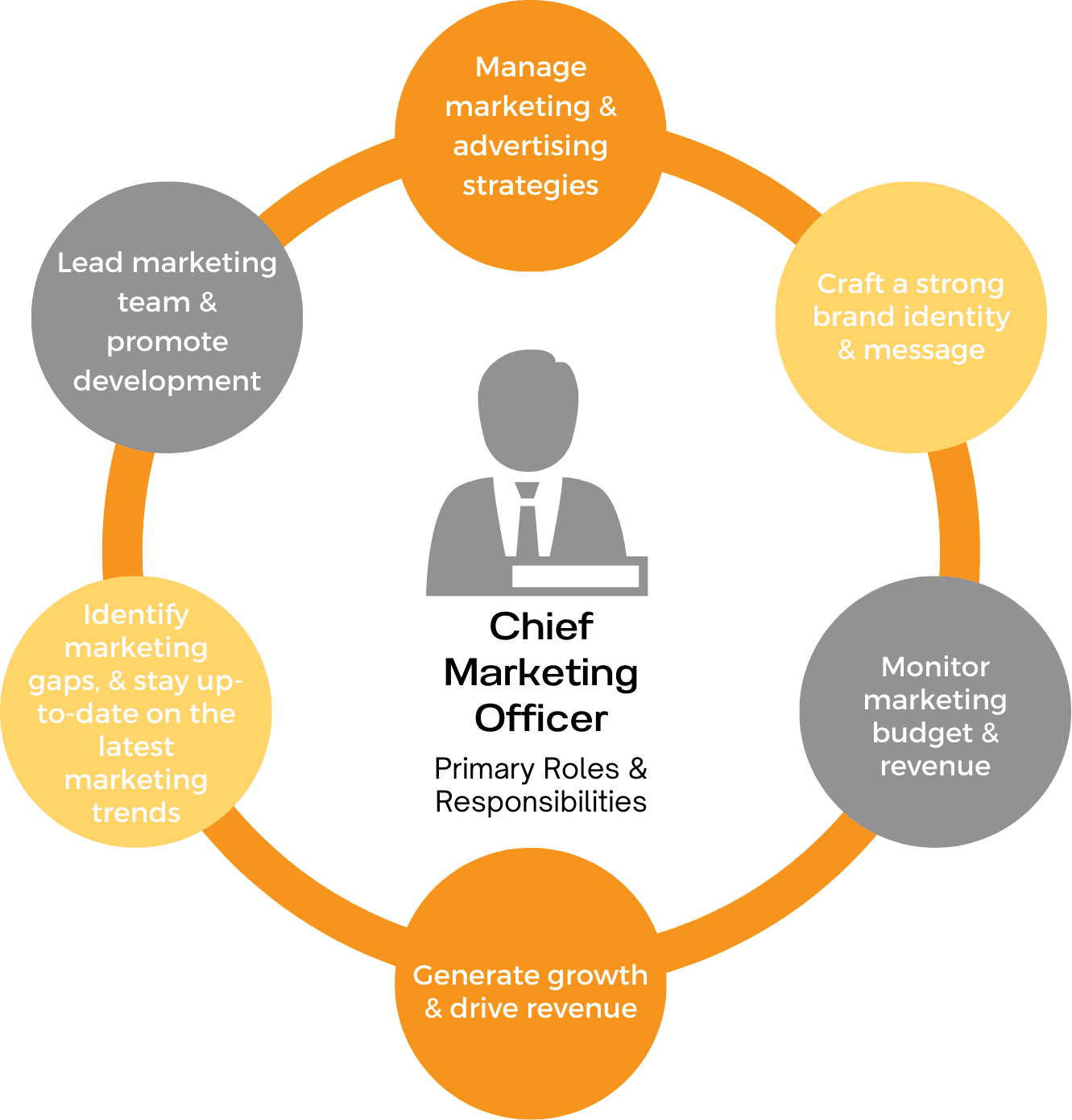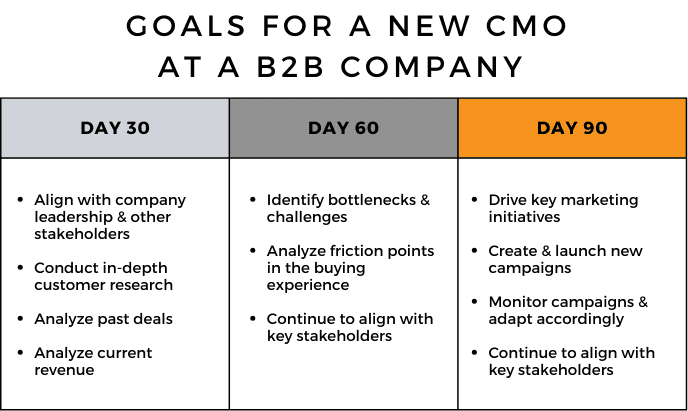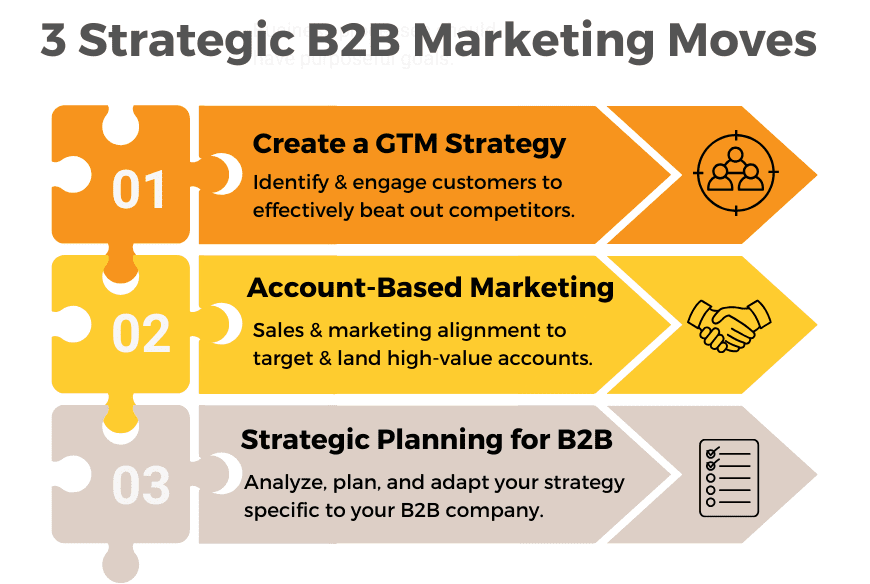B2B Chief Marketing Officers | How to Succeed in Your 1st 90 Days

A B2B Chief Marketing Officer’s Guide to Early Career Success
Here’s something we can all agree on: The first 90 days at a new job are critical for the long-term success of any employee. However, this is especially true for high-level corporate executive new hires at large B2B enterprises, such as chief marketing officers (CMOs).
Why? Because in just 3 months, a new CMO must:
- Build trust with their colleagues, accounts, & community partners
- Prove themselves to be a reliable problem-solver
- Begin to identify and fix marketing gaps
- Effectively land new target accounts
- Align with the B2B company’s brand image
Unfortunately, this major undertaking can quickly lead to disaster if you don’t show up with a strategic plan – no matter how much experience you have.
Sounds like a daunting undertaking, right? But, don’t worry.
In this ultimate guide, you will discover the resources you need to develop a strong game plan to master the first 90 days as a new CMO at your B2B company. Let’s dive right in!
What Are Chief Marketing Officers’ Primary Roles at a B2B Company?

As powerhouses of strategy and creativity, B2B CMOs use innovative ideas and structured plans to drive conversions and help their companies grow.
From the moment chief marketing officers are hired, their #1 responsibility is to oversee ALL of the marketing activities of the company. Underneath the umbrella of “marketing activities,” a CMO may be required to:
- Manage marketing and advertising strategies
- Identify marketing gaps
- Craft a strong brand identity and message
- Intimately understand the needs of their target market
- Set and meet KPIs for the company (i.e., revenue, customer engagement, etc.)
- Generate growth and engagement metrics
- Stay up-to-date on the latest marketing trends
- Monitor marketing budget and revenue
As you can see, this position isn’t for the faint of heart. However, with the right experience, proper planning, and a positive attitude, you can excel in this role.
First things first, proper planning ALWAYS starts BEFORE the first day on the job. Here’s what you need to know…
What New Chief Marketing Officers Should Do Before the First Day
For starters, do your homework! Even if this isn’t your first time as a CMO or your first position within this company, you must do as much research as possible before your start date.
As the CMO, it is your job to make sure day-to-day marketing activities are running smoothly. This means you MUST understand who you are working with, including stakeholders, competitors, and internal teams within your company.
Step 1: Connect with Key Stakeholders on LinkedIn
LinkedIn is one of the best networking tools available. Use it to your advantage and to help you get a better understanding of your new company before you even step foot in the office. Research their prole and history within the company, and start putting names to faces.
Take time to connect with key stakeholders on LinkedIn such as:
- Donors & Investors
- Project managers
- Boards of directors
- Employees
Taking the initiative to build relationships will not only allow you to understand your team and key leaders within the company, but the effort to build relationships before your first official start day will help you make a great first impression among your colleagues and other stakeholders.
Step 2: Research Your Primary Competitors
It’s no secret that knowledge is power. Chief marketing officers must equip themselves in advance!
You should begin by researching the primary competitors of your company. This will help you better understand the market, strategies, and trends.
Take the time to Identify your competitor’s current campaigns. Ask yourself: What are your new company’s campaigns doing that is better or worse than your competitor’s?
Conduct a simple SWOT analysis to get a bigger picture of your competitors and find areas of opportunities for your company. From there, you can begin to generate ideas for to scale company growth before your first day.
Proper preparation such as in-depth research will ensure your first day goes as smoothly as possible.
Step 3: Analyze the Relationship Between the Marketing & Sales Teams
Believe it or not, some internal challenges can be easily predicted or avoided altogether if you know what to look for. Here’s an example of a common obstacle CMOs face when they enter a new job.
Oftentimes, B2B enterprises place a hefty emphasis on either their sales team or their marketing team. This causes internal problems for the business because more capital and resources are allocated to one team over the other.

On one hand, your marketing team is responsible for attracting and engaging the key decision-makers at your target accounts. Meanwhile, your sales team is responsible for turning these accounts into repeat, high-value clients.
You will see a lot of strife arise between the marketing team and the sales team when ideas and strategies are misaligned, often due to miscommunication between departments. Instead, marketing and sales should work together and company resources should be effectively distributed to both teams.
As the new chief marketing officer of the company, you should do your due diligence and monitor the relationship between the teams BEFORE you start your job. That way, you can create an effective strategy to unite marketing and sales and get everyone on the same page – right off the bat!
Now, let’s walk you through the first 90 days so you can properly prepare and know what to expect as CMO of a B2B company.
What to Expect in the First 90 Days
Successful marketing campaigns don’t happen overnight.
For chief marketing officers, the first 90 days are a time to learn, align, and create a structured plan for the launch of successful campaigns. It is also the time to make strong connections with other key players in the business, such as the sales team, the CEOs of client accounts, and other stakeholders.
Here’s a short checklist of must-do activities during the first few months on the job:
- Learn about the company from the inside out, including team dynamics, processes, etc.
- Schedule regular meetings. Alignment with key stakeholders and team members is CRITICAL during the first 90 days.
- Set up KPIs and other metrics that fit the company’s vision. Share weekly updates with the CEO and CRO.
- Establish expectations and build team morale.
If you’ve made it this far in your career, then you know how critical goal setting is for success. During these first 90 days, you’ll need to set specific goals for yourself, the company, and your team as a whole.
Pro-Tip: We recommend breaking down your goals based on the first 30 days, the first 60 days, and the first 90 days. Consider building your own personal KPIs for each 30-day period!
In this next section, we’re going to take a closer look at what these goals should look like.
Breakdown of Your Goals as New CMO | 30-60-90 Days
Congrats! It’s your first day. Now what?
It’s time to set some goals. Let’s start with your first full month on the job.

What to Accomplish in the First 30 Days as CMO
Do you remember your first ever job?
Even if you were mowing your neighbor’s lawn or filing piles of paperwork as an intern, there’s something about the first day at any new job that never changes:
You always have a lot to learn.
Take this introductory period to learn as much as you can about the company’s current customer base, revenue take-in, and the types of deals they have won or lost in the past. Once you have a better understanding of the current presence of the company, you can set up much stronger marketing campaigns and KPIs for the future of the business.
Chief Marketing Officers Must Align With Company Leadership
Running a company is a lot like being in a band.
You and your leadership team can’t make great music together if you’re all playing the drums. Someone has to sing–and you can’t forget about the guitarist either. And if you’re out of sync, chances are your music won’t make the radio.
BUT, if you’re in sync, you can create chart-topping hits!

That’s why you must align with the CEO, CRO, and key stakeholders from day one. This is also a great time to gather company metrics and valuable information to help you best understand the company’s operations.
Remember, this isn’t a one-man show! It’s your job to make sure your goals are aligned with those of your new company.
Next, let’s take a look at a few checklists to help you get the ball rolling during your first 30 days.
Conduct Customer Research
As the chief marketing officer, we don’t need to tell you how essential it is to understand your target audience.
But, if you want to smash those KPIs and position yourself as an irreplaceable asset to the company, you’ll need to spend ample time during your first 90 days understanding the ins and outs of your target audience.
Here are some questions to ask yourself about your ideal customer:
- What value and results do they get from our product or service?
- Why did they choose us? How is our company different from our competitors?
- What triggered past customers’ buying process?
- How do they discover, evaluate, and choose our product?
- Who is involved in the purchasing process?
- What objections might they have to doing business with us?
For B2B companies, your target audience will often be a very specific group of people. In other words, they are the key decision makers who will either say ‘yes’ or ‘no’ to doing business with you.
Deal Analysis Checklist
This one is pretty self-explanatory. Take a look at the past deals the company has won or lost.
Get to the why–why did we win x client, but not y client? What did we do well? What could we do differently going forward?
At the end of your analysis, you should be able to identify:
- The LARGEST deal WON and LOST + potential reasons for each outcome
- The FASTEST deal WON + potential reasons for the outcome
This is a great time to collect qualification & disqualification criteria as well.
Current Revenue Analysis Checklist
During your first 2 months, you should spend time analyzing current revenue. Look for patterns and identify your historically successful deals–and most importantly, understand why they were successful.
Ask yourself the following questions while you begin analyzing company revenue:
- What percentage of our current revenue is from upsells?
- What percentage of our customers could we have upsold, but didn’t?
- What is the average length of customer retention?
- Are there any patterns among the longest-staying customers and those with the biggest lifetime value (LTV)? How about those that churn the most?
- Is there any seasonality that affects our business?
At the end of the day, hitting your revenue KPIs is oftentimes a sign of success. Not only will this make you look good, but it will also make the CEO and other stakeholders very happy!
Get This Done in 60 Days
Now that you’ve had the time to get a baseline assessment of your industry, it’s time to create a strategy for the upcoming quarters.
Of course, you should continue to learn and adapt each day, but by day 60, you should have begun creating a detailed roadmap with in-depth KPIs that align with company goals, and work on launching multi-channel target campaigns that will help you hit these KPIs.
Start highlighting areas that you’d like to see change from your analysis, and implement a game plan with an estimated timeline of completion. Here are a couple of analyses you can use to build the foundation of your overall strategy.
Bottlenecks & Challenges Analysis

Pay attention! This is SUPER important! To the best of your ability, you must identify any challenges and bottlenecks found within your marketing team AND the sales team.
Some common challenges that B2B marketing and sales teams face include:
- A longer-than-normal sales cycle for your industry that doesn’t land you high-value accounts
- Poor collaboration between sales and marketing, resulting in miscommunication and unaligned goals
- The marketing team consistently generates a higher number of disqualified leads than qualified leads for the sales team
Don’t be afraid to pass out surveys or host engaging and private meetings with key members of each team to get an insider look at any obstacles they may face.
Pro-Tip: Make sure you go into these meetings with an open and transparent attitude. Remember, you’re here to make everyone’s life easier and improve performance for the entire business. Your teams will respect you as an honest and trustworthy leader!
Friction Point Analysis
Are there any friction points for customers during their buying experience? What about UX (user experience) pains for target accounts or partners during the client acquisition process? And last but not least, are there friction points between your marketing and sales teams?
Some examples of friction points in the buyer and user experience may include:
- Confusing or complex buying process for the buyer
- Little to no personalization, resulting in low engagement and interest
- Poor customer support stemming from the sales and/or marketing team
Chief marketing officers must identify and alleviate these friction points to close more deals and secure more long-term clients and partners.
Set Yourself Up For Success By Day 90
At this point, you understand how things work and have already begun implementing changes to increase conversions and promote company growth.
During your 3rd month as CMO, take time to set new goals and focus on adapting and planning for the future. Ask yourself:
Where are there opportunities for growth and improvement? How can I make that growth happen?
Make sure you continue to evaluate your own performance as well as those of your employees.
Chief Marketing Officers Should Drive These Key Marketing Initiatives

Here are a couple of key initiatives you can take before you hit 90 days.
- Improve and scale campaigns that are already working
- Research and launch a new channel or program that you believe will greatly benefit the business
- Develop playbooks for account development and activation
- Establish clear goals with leading indicators to measure campaign progress in each quarter
Pro-Tip: Keep in mind that you don’t have to complete every single one of these initiatives from start to finish in just 90 days. However, it’s good to have them in your mind as you strategically plan and set up milestones for each quarter.
Chief Marketing Officers Must Create & Launch New Campaigns ASAP
When it comes to new marketing campaigns, you must be actively involved, especially during new launches within your first 90 days.
- Host regular campaign check-ins with your team (weekly, at a minimum)
- Involve the sales team. Conduct an occasional pipeline review
- Always run campaign postmortems to see what did well and what can be improved for future campaigns
- Communicate with 100% transparency to all members involved
Launching campaigns takes a team, so you must constantly communicate with key team leaders about the ins and outs of each campaign. This is a great opportunity to show your leadership skills and build team rapport through regular meetings and check-ins.
And remember, don’t just celebrate your wins – congratulate the team behind the success!
3 Strategic Marketing Moves All B2B Chief Marketing Officers Should Consider

In this next section, we’re going to expand on some other important strategy ideas for you to consider during your first 3 months as the new B2B chief marketing officer.
First off, let’s take a quick look at go-to-market strategies.
1. Create a Go-to-Market Strategy
A go-to-market (GTM) strategy is a plan that companies use to engage customers, convince them to buy their product/service, and beat out their competitors.
It’s important to note that these goals can vary depending on:
- Industry & vertical
- Individual service/product
- Opportunity source
- Territory
A great example of a GTM strategy is account-based marketing (ABM). Keep reading to learn more about this B2B-specific strategy.
2. Sales Alignment: Account-Based Marketing for B2B
Remember when we said you should align your goals with your sales AND marketing team? Let’s take it a step further.
One of the best B2B strategies for mid to large-size companies is account-based marketing (ABM). Unlike traditional inbound marketing, sales and marketing work closely toward the same objective in ABM to land target accounts.
Using your ICP to create an ABM strategy, you can stop casting a wide net, hoping to catch your ideal customers. Instead, you start creating customized plans to target specific companies and decision-makers.
So, what are the benefits of ABM?
ABM helps you rise above the competition, land high-value clients, and increase revenue. It’s an extremely successful option for B2B companies and a strategy you should consider within your first 90 days.
But beware: ABM isn’t for every B2B company. Make sure you use an ABM fit checklist to test if your company qualifies for ABM before you strategize.
3. Strategic Planning for B2B Industries
At this point, you’ve gotten to know the people and processes behind the brand. Now it’s time to start making impactful changes and hitting KPIs.
As a CMO, you should always be analyzing, planning, and adapting your strategy to create the best plan for the company. When it comes to resource planning and quarterly planning, here are a few suggestions:
- Operationalize proven programs to create success
- Continue to craft clear goals and objectives, setting detailed KPIs
- Implement a dashboard to track and report on results and marketing-sourced revenue
- Increase product and customer knowledge of marketers
- Continue to oversee budget allocation and adapt accordingly
As always, make sure to check in with the CEO, CRO, and any other key stakeholders to make sure your goals are aligned.
What Success Looks Like AFTER the First 90 Days for Chief Marketing Officers
Success looks different for everyone–no matter the position. If you can accomplish the goals you set for yourself within the first 90 days, you’ll set yourself and your team up for future success.
Going forward, it’s important to continuously analyze and adapt your strategies to excel in your position and help the company grow.
Partner with Chatter Buzz to Surpass Your 90-day Goals
Need inbound marketing or account-based marketing expertise for your B2B company?
At Chatter Buzz Media, our team of strategists has helped countless B2B companies generate brand awareness, land high-value customers, and increase ROI. When you partner with us, you’ll receive the skills of our full-service team at a fraction of the cost associated with recruiting, training, or hiring employees.
Contact our strategists today to discover how we can help you exceed your company’s goals.
Do you need someone to help you achieve your growth goals - then let us help you crush them? Let's chat!
Error: Contact form not found.










